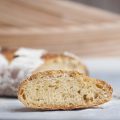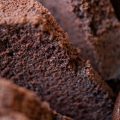Wild garlic has antibacterial properties and it also helps to reduce blood pressure, especially when eaten in large quantities. It can be used in salads, soups, eaten fresh in spreads, with pasta, smoothies…you name it! I’ve decided to mix it into bread. I made two wild garlic bread versions, one with white wheat and Khorasan wheat flour and another whole grain wheat flour, just to see how the taste and color would be affected. Check out my wild garlic sourdough recipes in this post!
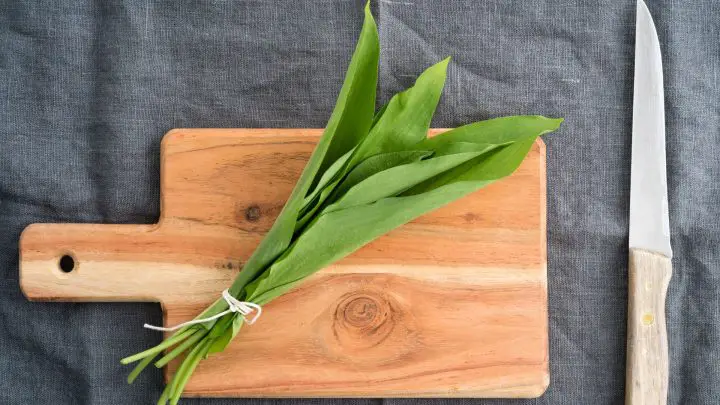
Table of Contents
- Wild garlic (Allium ursinum L.)
- Khorasan Wheat and 100% Whole Grain Wheat Sourdough Bread Recipes
- Thank You!
- FAQs
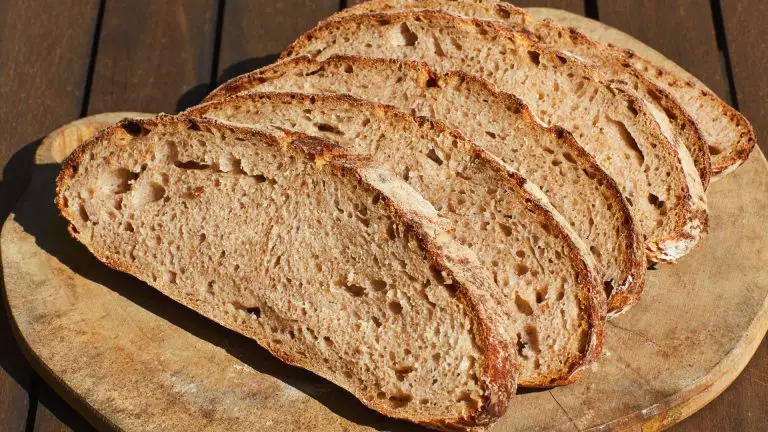
Khorasan Wheat and 100% Whole Grain Wheat Sourdough Breads With Wild Garlic Recipe
- Total Time: 22 hrs 57 mins
- Yield: 1 loaf each 1x
Ingredients
100% Whole Grain Wheat Sourdough Bread
- 400 g whole grain wheat flour
- 315 g water + 15 g water (82% hydration)
- 100 g active whole grain wheat sourdough starter (70% hydration)
- 8 g fine sea salt
- 1.5 tablespoon of wild garlic pesto or 2 handfuls of wild garlic finely chopped
Khorasan Wheat Sourdough Bread
- 200 g white Khorasan wheat flour
- 250 g white wheat flour
- 300 g water (66% hydration)
- 100 g active rye sourdough starter (100% hydration)
- 9 g fine sea salt
Instructions
- In the morning of the day you will mix the dough, prepare your sourdough starter. Mix 70 g of whole grain wheat flour with 50 g of water and one teaspoon of your active (or straight from the fridge) sourdough starter.
- In the evening, first mix 315 g of water, 100 g of active whole grain wheat sourdough starter, and 400 g of whole grain wheat flour. Mix until all ingredients come together. Leave to rest (autolyse) for 30-60 minutes.
- Observe how the flour has absorbed the water during the resting period. If you don’t know how well your flour absorbs the water, the resting period is a good choice to test it.
- Add 8 g of salt and 15 g of water. If the dough feels stiff, add more water. Knead the dough for couple of minutes.
- Leave the dough to rise for another 2.5-3 hours at the room temperature (if it’s too cold, you might put the bowl in a slightly warm oven). If you like, you can apply few stretch and folds to the dough. To make one stretch and fold, grab the dough underneath, stretch it up and fold it back onto itself.
- In the meantime, prepare the rising basket and flour it well. I lined my rising basket with a kitchen cloth and floured it with whole grain rye flour and white wheat flour.
- After 2.5-3 hours, the dough should look slightly puffed. Take the dough out on a lightly floured working surface and shape it into a ball by pinching the ends of the dough together in the middle and then transfer the dough to a rising basket. Sprinkle some more flour on the top and cover it with the rest of the kitchen cloth.
- Put the basket in the fridge. Let the dough ferment until noticeably risen in volume and when the indent you make with your finger springs back slowly and not all the way up. It usually take my dough 10-12 hours.
- When the dough has risen enough, put the Dutch oven (or a baking stone) into oven and heat it to the maximum temperature of your oven for at least 30 minutes.
- When Dutch oven/baking stone is preheated, take it out. Put a piece of parchment paper and a chopping board over the rising basket and turn everything upside down. Score the bread and transfer it to a dutch oven.
- Bake the bread for 20 minutes with the lid on (or with steam – to create steam, throw couple of ice cubes onto the hot pan at the bottom of the oven) at 240°C/465F°F and 20-25 minutes with lid off at 230°C/445°F and until bread gets nice golden color.
- Cool on a cooling rack before cutting for at least 1 hour.
Notes
- Both breads were mixed in the evening, left to rise for 3 hours at the room temperature, shaped and then put in the fridge for 10-12 hours. They were baked in the morning of the following day.
- Instructions are written for 100% whole wheat sourdough bread but to be applied to the Khorasan wheat sourdough bread as well.
- Prep Time: 22 hrs 2 mins
- Cook Time: 55 mins
- Category: bread
The Universe always offers us the opposites, the complementary sides of life. Sometimes it takes more time and effort to see them, but it is worth it. Without them we could not thrive.
How would a colorful and hearth-warming spring feel without grounding winter? How would joy feel without sadness? How would sadness feel without joy? Would we appreciate opportunities without being rejected?
It’s through the opposites the Universe teaches us not to cling to any of two sides, but to stay in the middle, to be in the balance, to be in the now and to feel gratitude – for what it is, as it is, and as it is unfolding in front of us.
I love how the spring gradually unfolds itself. Daffodils, morning bird singing, blooming forsythias. And wild garlic, free and early fresh green herb of the year to harvest. Yes, it’s wild garlic season!
Wild garlic is also known as the bear’s garlic, as the bears awakened from the winter hibernation would dig up to the ground to get the bulbs and leaves that would help them detoxify. It’s after the bear (Ursus arctos L.) that the plant got its Latin name – Allium ursinum L. In German, wild garlic is called Bärlauch, in French ail des ours, in Dutch beerlook and in Italian erba orsina.
I live in a part of the country which is known for being a brown bear’s natural habitat, so picking wild garlic is always a bit adventurous for me. You know, how would the inner calmness feel without the outer excitement? 🙂
Wild garlic (Allium ursinum L.)
Also known as ramsons or wood garlic, wild garlic can be found in deciduous (sometimes also in coniferous) woodlands with moist and slightly acidic soil.
If you pay attention when walking through through the forest, the typical garlic-like scent should be present in the air. The smell gets more obvious if you rub couple of wild garlic leaves between your fingers.
This is a good test to distinguish wild garlic from other similar looking but poisonous plants like Lily of the Valley (Convalaria majalis L.), autumn crocus (Colchicum autumnale L.) and false helleborine (Veratrum album L.). However, if the garlic scent is on your fingers, avoid picking other plants and testing them by rubbing them between the fingers afterwards.
Three other wild garlic features are: convex leaves with one main vein, individual green stem, and long white bulb. It flowers in white in the end of April or beginning of May or even later at higher altitudes.
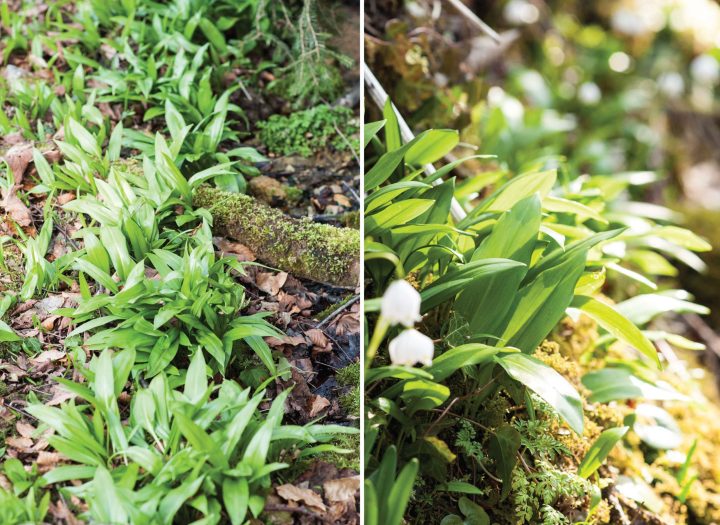
Wild garlic has antibacterial properties and it also helps to reduce blood pressure, especially when eaten in large quantities. It can be used in salads, soups, eaten fresh in spreads, with pasta, smoothies…you name it! I’ve decided to mix it into bread.
I made two breads, one with white wheat and khorasan wheat flour and another whole grain wheat flour, just to see how the taste and color would be affected.
Fresh wild garlic (or pesto) will give your bread a unique (almost salami-like) taste. However the color of the dough in whole grain wheat sourdough bread will not be affected (i.e. changed to green).
To get a greener crumb, use more wild garlic or use white flours to make the change in color more pronounced.
When I made my first sourdough bread with (a lot of) wild garlic, it didn’t rise. I was thinking if its antibacterial properties affected the bacteria in my starter. So it was a failed first wild garlic bread recipe attempt. It’s normal for making bread not to turn out perfectly on the first try!
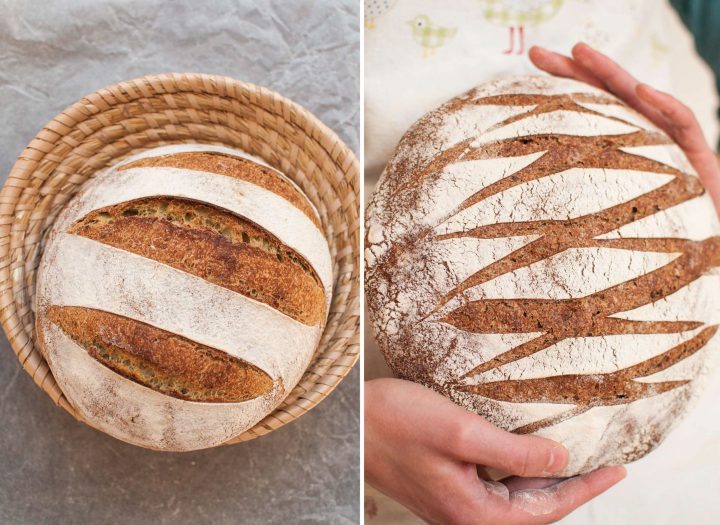
Khorasan Wheat and 100% Whole Grain Wheat Sourdough Bread Recipes
This recipe yields one small to medium loaf each.
Baking Schedule
Both breads were mixed in the evening, left to rise for 3 hours at the room temperature, shaped and then put in the fridge for 10-12 hours.
They were baked in the morning of the following day.
Ingredients for 100% Whole Grain Wheat Sourdough Bread
- 400 g whole grain wheat flour
- 315 g water + 15 g water (82% hydration)
- 100 g active whole grain wheat sourdough starter (70% hydration)
- 8 g fine sea salt
- 1.5 tablespoon of wild garlic pesto or 2 handfuls of wild garlic finely chopped
Ingredients for Khorasan Wheat Sourdough Bread
- 200 g white Khorasan wheat flour
- 250 g white wheat flour
- 300 g water (66% hydration)
- 100 g active rye sourdough starter (100% hydration)
- 9 g fine sea salt
Instructions
(These are written for 100% whole wheat sourdough bread, but should be applied to the Khorasan wheat sourdough bread as well).
- In the morning of the day you will mix the dough, prepare your sourdough starter. Mix 70 g of whole grain wheat flour with 50 g of water and one teaspoon of your active (or straight from the fridge) sourdough starter. On the photo below you can see my starter in the morning (left) and couple of hours later (right).
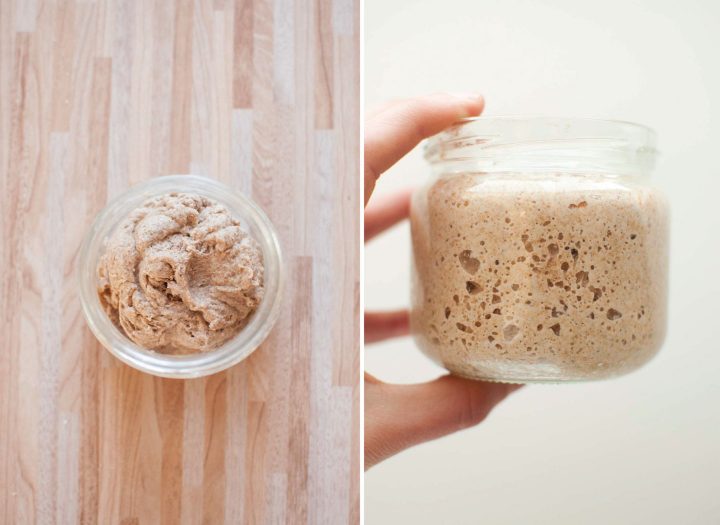
- In the evening, first mix 315 g of water, 100 g of active whole grain wheat sourdough starter, and 400 g of whole grain wheat flour. Mix until all ingredients come together. Leave to rest (autolyze) for 30-60 minutes.
- Observe how the flour has absorbed the water during the resting period. If you don’t know how well your flour absorbs the water, the resting period is a good choice to test it.
- Add 8 g of salt and 15 g of water. If the dough feels stiff, add more water. Knead the dough for couple of minutes.
- Leave the dough to rise for another 2.5-3 hours at the room temperature (if it’s too cold, you might put the bowl in a slightly warm oven). If you like, you can apply few stretch and folds to the dough. To make one stretch and fold, grab the dough underneath, stretch it up and fold it back onto itself.
- In the meantime, prepare the rising basket and flour it well. I lined my rising basket with a kitchen cloth and floured it with whole grain rye flour and white wheat flour.
- After 2.5-3 hours, the dough should look slightly puffed. Take the dough out on a lightly floured working surface and shape it into a ball by pinching the ends of the dough together in the middle and then transfer the dough to a rising basket. Sprinkle some more flour on the top and cover it with the rest of the kitchen cloth. Put the basket in the fridge. Let the dough ferment until noticeably risen in volume and when the indent you make with your finger springs back slowly and not all the way up. It usually take my dough 10-12 hours.

- When the dough has risen enough, put the Dutch oven (or a baking stone) into oven and heat it to the maximum temperature of your oven for at least 30 minutes.
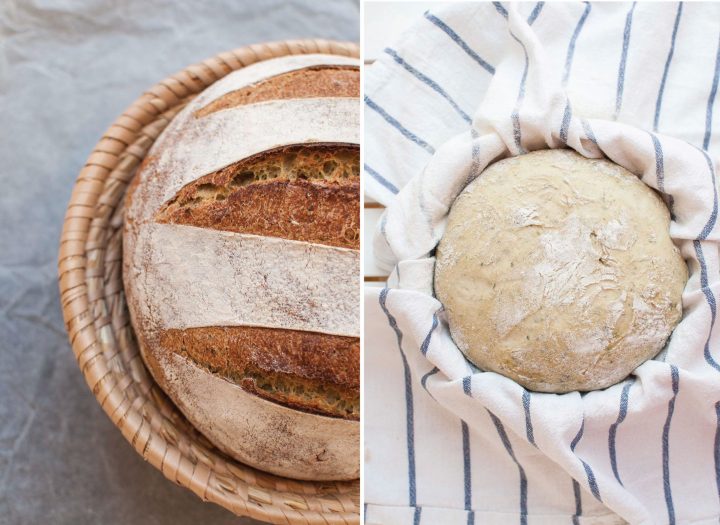
- When dutch oven/baking stone is preheated, take it out. Put a piece of parchment paper and a chopping board over the rising basket and turn everything upside down. Score the sourdough bread and transfer it to a dutch oven.
- Bake the bread for 20 minutes with the lid on (or with steam – to create steam, throw couple of ice cubes onto the hot pan at the bottom of the oven) at 240°C/465F°F and 20-25 minutes with lid off at 230°C/445°F and until bread gets nice golden color.
- If you’re like me and you love wild garlic, you may not be able to resist your delicious loaf. But remember to cool on a cooling rack before cutting for at least 1 hour after baking bread.
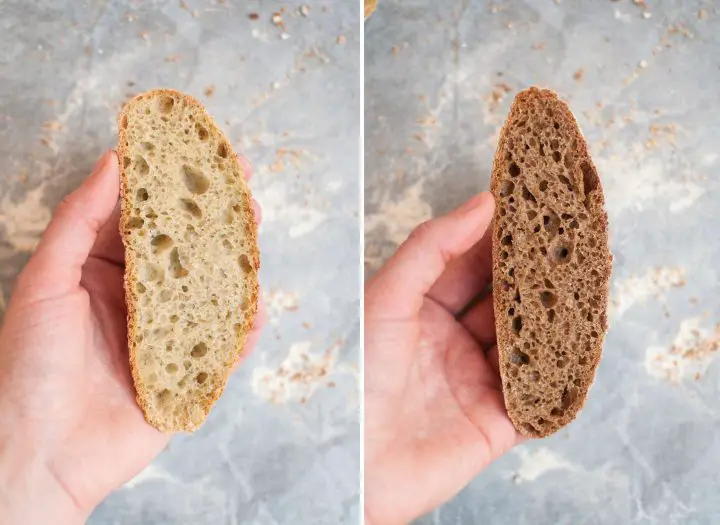
My wild garlic bread loaves turned out amazing!
Check out my post on what you can eat with sourdough for pairing ideas for your wild garlic bread. Or if you’re looking for more garlic recipes, here’s my garlic sourdough bread, if that’s what you’re in the mood for. I also have another sourdough pesto recipe using pumpkin seeds.
If you’re feeling something sweet, try my Scrumptious Sourdough Hot Cross Buns or Einkorn Sourdough Bread.
What’s your favorite spring harvest?
Here are other ideas on what you can do with wild garlic:
Thank You!
Something really magnificent and totally unexpected happened two weeks ago – My Daily Sourdough Bread blog was selected from a record-breaking pool of nearly 50,000 entries as the one of the six finalists in the Best Special Interest Blog category in Saveur Blog Awards 2015!

I can’t describe with words how grateful I am to be in a company of all beautiful and inspiring blogs and how grateful I am for your support in the first round!
FAQs
Does garlic powder affect yeast?
Garlic powder itself does not directly affect yeast, as it is a dried and powdered form of garlic that has had its moisture removed. However, if garlic powder is used in a recipe that contains yeast, it may indirectly affect the yeast by altering the pH or other conditions of the dough or batter.
Garlic is naturally acidic (pH ranging from 5.5 to 7.5, depending on the variety and how it is prepared). Yeast, on the other hand, thrives in a slightly alkaline environment (pH of around 7.0 to 8.5). So if too much garlic powder is added to a recipe that contains yeast, it may lower the pH of the dough or batter, making it more acidic and less hospitable to the yeast.
However, in most cases, the amount of garlic powder used in a recipe is not enough to significantly affect the pH or other conditions of the dough or batter. So it is unlikely to have a noticeable impact on the yeast.
If you are concerned about how garlic powder might affect your recipe, you can always start with a small amount. Gradually increase it to taste, while monitoring the rise and texture of the dough or batter.
Does garlic powder affect bread rise?
Garlic powder in small amounts is unlikely to significantly affect the rise of bread. However, if too much garlic powder is added to the bread dough, it can potentially affect the bread’s rise due to its acidic properties.
Yeast requires a slightly alkaline environment to grow and produce carbon dioxide, which is responsible for the bread’s rise. If the pH of the bread dough becomes too acidic due to the addition of too much garlic powder, it can hinder the yeast’s ability to rise and ferment the dough properly.
That being said, garlic powder is typically added to bread dough in small amounts, and the acidity it contributes is usually not significant enough to have a major impact on the bread’s rise. Additionally, many bread recipes contain other ingredients such as sugar or honey, which can help counteract the acidity of the garlic powder.
In summary, while garlic powder has the potential to affect the rise of bread if used in excess, it is typically used in small enough amounts that it is unlikely to have a significant impact on the bread’s overall rise.
How does garlic affect yeast fermentation?
Garlic can affect yeast fermentation in two ways: through its antimicrobial properties and its acidity.
Garlic contains a compound called allicin, which has antimicrobial properties. Allicin can inhibit the growth of certain bacteria and fungi, including some strains of yeast. While this may seem like a negative effect on yeast fermentation, in reality, the inhibition of certain microbes can actually be beneficial for yeast growth and fermentation. By reducing the competition for resources, the yeast can grow and ferment more efficiently.
The acidity of garlic can also affect yeast fermentation. Garlic is naturally acidic, and if too much garlic is added to a recipe, it can lower the pH of the dough or batter. Yeast prefers a slightly alkaline environment, so if the pH becomes too acidic, it can hinder the yeast’s ability to grow and ferment the dough properly.
That said, in most cases, the amount of garlic used in a recipe is not enough to significantly affect the pH or inhibit yeast growth. Additionally, many bread recipes contain other ingredients, which can help counteract the acidity of the garlic.
Can you use wild garlic leaves in baking?
Yes, you can use wild garlic leaves in baking. One way to incorporate wild garlic leaves into your bakes is to chop them finely. Add them to bread dough or pastry dough. You can also add wild garlic leaves to savory muffins or scones, or use them as a topping for focaccia or pizza. There’s no limit to what you can bake with wild garlic leaves!

